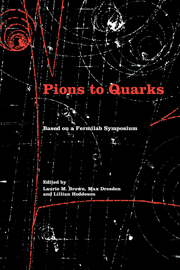Book contents
- Frontmatter
- Contents
- List of contributors
- Foreword by Leon M. Lederman
- Editors' acknowledgments
- Photographs of the symposium
- List of abbreviations
- List of notation
- I Introduction
- II Particle discoveries in cosmic rays
- III High-energy nuclear physics
- 6 Learning about nucleon resonances with pion photoproduction
- 7 A personal view of nucleon structure as revealed by electron scattering
- 8 Comments on electromagnetic form factors of the nucleon
- IV The new laboratory
- V The strange particles
- VI Weak interactions
- VII Weak interactions and parity nonconservation
- VIII The particle physics community
- IX Theories of hadrons
- X Personal overviews
- Name index
- Subject index
7 - A personal view of nucleon structure as revealed by electron scattering
Published online by Cambridge University Press: 07 May 2010
- Frontmatter
- Contents
- List of contributors
- Foreword by Leon M. Lederman
- Editors' acknowledgments
- Photographs of the symposium
- List of abbreviations
- List of notation
- I Introduction
- II Particle discoveries in cosmic rays
- III High-energy nuclear physics
- 6 Learning about nucleon resonances with pion photoproduction
- 7 A personal view of nucleon structure as revealed by electron scattering
- 8 Comments on electromagnetic form factors of the nucleon
- IV The new laboratory
- V The strange particles
- VI Weak interactions
- VII Weak interactions and parity nonconservation
- VIII The particle physics community
- IX Theories of hadrons
- X Personal overviews
- Name index
- Subject index
Summary
I was graduated from City College of New York in 1935 after majoring in physics and mathematics. In my early years in college I was stimulated by my teachers Irving Lowen and Mark Zemansky. From both I learned to appreciate clarity and precision in thinking. I believe I owe to Zemansky the opportunity of entering the Princeton Graduate School in 1935. I suppose he wrote good letters of recommendation to the Princeton Admission Committee and to the General Electric Company's board of advisors for their Charles A. Coffin Foundation Fellowship. I had the Coffin Fellowship for the year 1935–6, and a stipulation of that fellowship was that I had to be involved in research, even in my first year of graduate study. This condition weighed pretty heavily on me, and as a result of advice from Harry Smyth, then chairman of the Physics Department, I started working with Louis Ridenour on a Wilson cloud-chamber project. Earlier, I had given some theoretical assistance to Walker Bleakney in his design of a new mass spectrograph operating on a cycloidal trajectory principle. Because of the time I spent on research, I really had much less time than I wanted for course work, in particular in the quantum mechanics course I took from Eugene Wigner.
In my second year, now with an assistantship to E. U. Condon, I really tried hard to become a theorist. I was strongly influenced by Condon, and now that I can think back about it, I should have been.
- Type
- Chapter
- Information
- Pions to QuarksParticle Physics in the 1950s, pp. 126 - 143Publisher: Cambridge University PressPrint publication year: 1989

